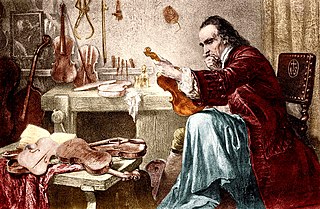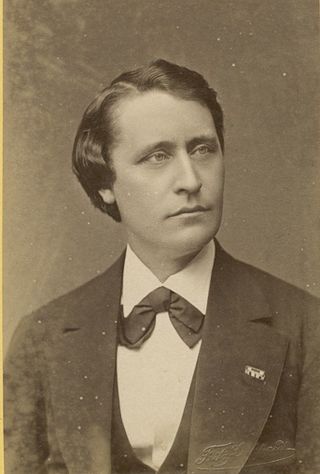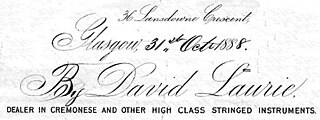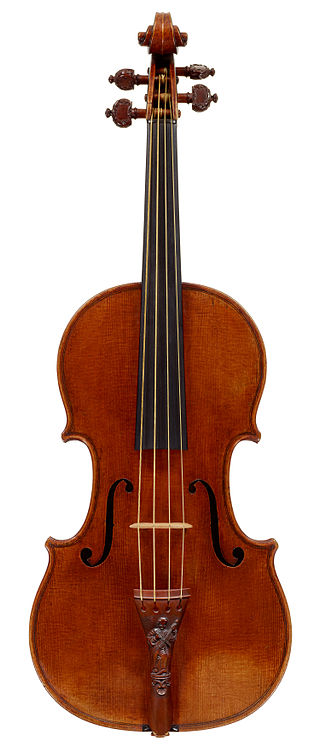
Antonio Stradivari was an Italian luthier and a craftsman of string instruments such as violins, cellos, guitars, violas and harps. The Latinized form of his surname, Stradivarius, as well as the colloquial Strad are terms often used to refer to his instruments. It is estimated that Stradivari produced 1,116 instruments, of which 960 were violins. Around 650 instruments survive, including 450 to 512 violins. His instruments are considered some of the finest ever made, and are extremely valuable collector's items.

A Stradivarius is one of the violins, violas, cellos and other string instruments built by members of the Italian family Stradivari, particularly Antonio Stradivari, during the 17th and 18th centuries. They are considered some of the finest instruments ever made, and are extremely valuable collector's items.

Jean-Baptiste Vuillaume was a French luthier, businessman, inventor and winner of many awards. His workshop made over 3,000 instruments.
The Soil Stradivarius of 1714 is an antique violin made by Italian luthier Antonio Stradivari of Cremona (1644–1737). It is one of 700 known existent Stradivari instruments. The instrument was made during Stradivari's "golden period" and is named after the Belgian industrialist Amédée Soil. The current owner of the violin is violinist Itzhak Perlman.
The Viotti; ex-Bruce Stradivarius of 1709 is an antique violin constructed by luthier Antonio Stradivari of Cremona (1644–1737). It is one of only 700 known extant Stradivari instruments.

The Betts Stradivarius is a violin made in 1704 by the Italian luthier Antonio Stradivari of Cremona. It is one of around 650 known extant Stradivari instruments.
Luigi Tarisio was an Italian violin dealer and collector.

The violin, viola and cello were first built in the early 16th century, in Italy. The earliest evidence for their existence is in paintings by Gaudenzio Ferrari from the 1530s, though Ferrari's instruments had only three strings. The Académie musicale, a treatise written in 1556 by Philibert Jambe de Fer, gives a clear description of the violin family much as we know it today.

Bartolomeo Giuseppe "del Gesù" Guarneri was an Italian luthier from the Guarneri family of Cremona. He rivals Antonio Stradivari (1644–1737) with regard to the respect and reverence accorded his instruments, and for many prominent players and collectors his instruments are the most coveted of all. Instruments made by Guarneri are often referred to as Del Gesùs.
The Alard–Baron Knoop Stradivarius of 1715 is an antique violin made by luthier Antonio Stradivari of Cremona (1644–1737). It was made during Stradivari's golden period and is regarded as the "finest of the fine," and nec plus ultra by the W.E. Hill & Sons. The Alard has the original neck with the initials "PS" found in the mortise of the head believed to be those of son, Paolo Stradivari. The Hill brothers conclude this violin is one of the instruments that came into Paolo's possession upon the death of his brother Francesco in 1742.
W. E. Hill & Sons is a British firm based in London that specialises in violins and other string instruments, and bows. It was also known as William Ebsworth Hill & Sons or William E. Hill & Sons.
The "General Kyd" is a nickname applied to several Stradivarius instruments crafted by Italian luthier Antonio Stradivari of Cremona and owned for a time by British General Alexander Kyd. They include a violin made in 1714, a violin made in 1720, and the General Kyd; ex-Stern Stradivarius cello made in 1684. These instruments have been owned and played by some of the world's leading musicians. The 1714 violin was owned from about 1980 to 1990 by Itzhak Perlman, who made most of his early recordings using this instrument. The 1720 violin's owners included composer Rebecca Clarke.

The Lauterbach Stradivarius of 1719 is an antique violin fabricated by Italian luthier, Antonio Stradivari of Cremona (1644–1737). The instrument derives its name from previous owner, German virtuoso, Johann Christoph Lauterbach.

David Laurie - was a distinguished 19th century violin collector.

Tarisio is the world's largest seller of fine stringed instruments and bows. Founded in 1999 as an auction house that specializes in string instruments and bows, Tarisio now has locations in New York, London and Berlin and serves a global clientele.

Nicola Amati, Nicolò Amati or Nicolao Amati was an Italian master luthier from Cremona, Italy. Amati is one of the most well-known luthiers from the Casa Amati. He was the teacher of illustrious Cremonese School luthiers such as Andrea Guarneri and Giovanni Battista Rogeri. While no clear documentation exists for their being apprentices in his shop, Amati may also have apprenticed Antonio Stradivari, Francesco Rugeri, and Jacob Stainer, as their work is heavily influenced by Amati.

The Lady Blunt is a Stradivarius violin made in 1721 by the renowned Italian luthier Antonio Stradivari. It is named after one of its first known owners, Lady Anne Blunt, the British co-founder of the Crabbet Arabian Stud.

Count Ignazio Alessandro Cozio di Salabue (1755–1840) was an Italian nobleman who was known as the first great connoisseur and collector of violins. A trove of correspondence and memoirs on the history of violinmaking known as the Carteggio forms the basis of his biography. Cozio's meticulous notes on nearly every instrument that passed through his hands contributed enormously to the body of knowledge surrounding Italian violinmaking.
The Langonet Dynasty were a family of violin makers originating in Mirecourt, France, from around 1737 until the late 1900s.











